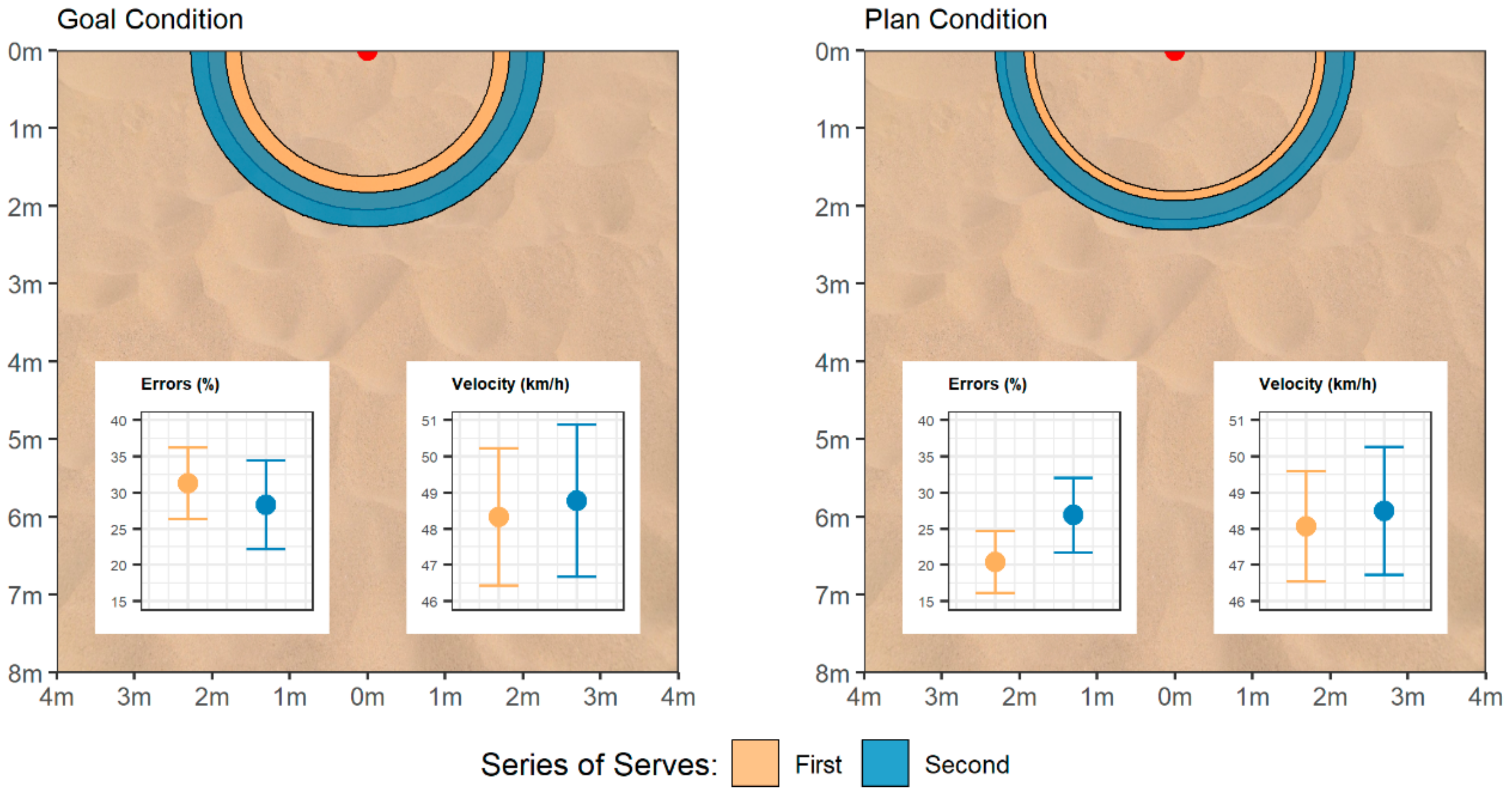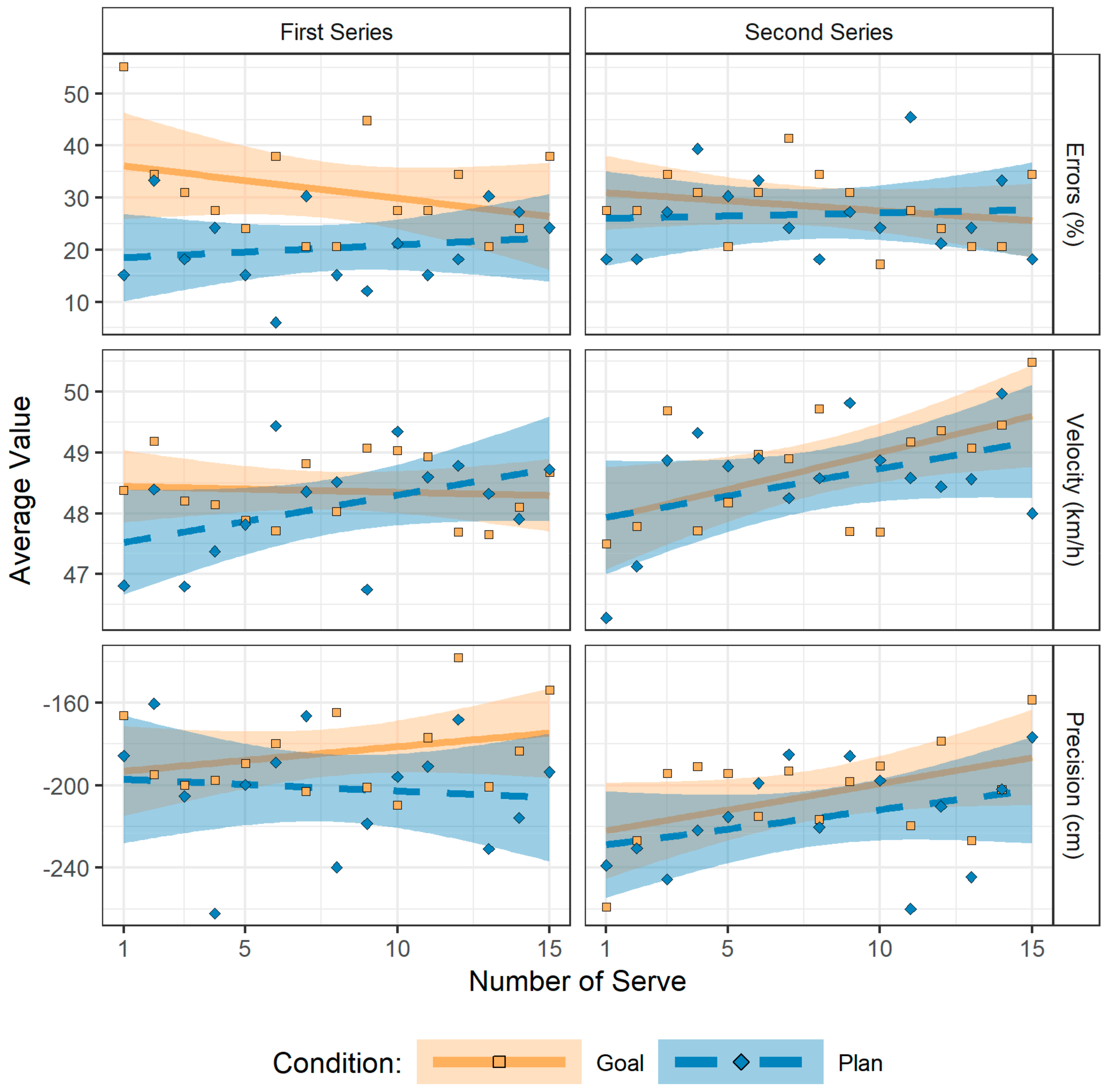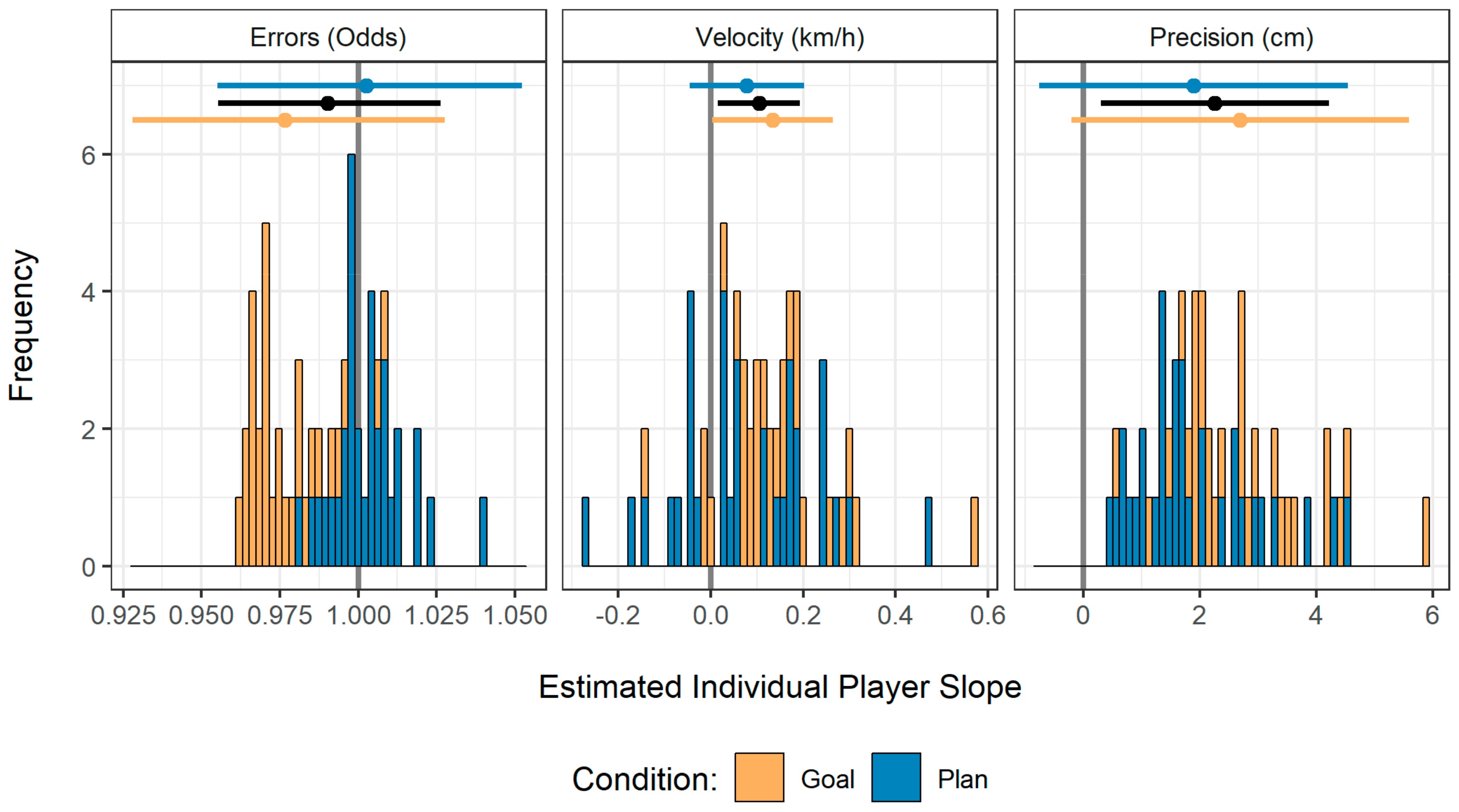Served Well? A Pilot Field Study on the Effects of Conveying Self-Control Strategies on Volleyball Service Performance
Abstract
1. Introduction
2. Materials and Methods
2.1. Participants
2.2. Materials and Instruments
2.2.1. Objective Performance
2.2.2. Coach Ratings
2.2.3. Final Questionnaire
2.3. Procedure
2.4. Data Analysis
3. Results
3.1. Performance Motivation
3.2. Aggregate Performance
3.3. Development of Performance
3.3.1. First series of Serves
3.3.2. Second Series of Serves
3.4. Coach Ratings of Performance Improvements
4. Discussion
4.1. Implications
4.2. Limitations
5. Conclusions
Author Contributions
Funding
Conflicts of Interest
References
- Singer, N.N. Performance and human factors: Considerations about cognition and attention for self-paced and externally-paced events. Ergonomics 2000, 43, 1661–1680. [Google Scholar] [CrossRef] [PubMed]
- Singer, N.N. Strategies and metastrategies in learning and performing self-paced athletic skills. Sport Psychol. 1988, 2, 49–68. [Google Scholar] [CrossRef]
- Yiannis, L.; Panagiotis, K. Evolution in men’s volleyball skills and tactics as evidenced in the Athens 2004 Olympic Games. Int. J. Perform. Anal. Sport 2005, 5, 1–8. [Google Scholar] [CrossRef]
- Rokito, A.S.; Jobe, F.W.; Pink, M.M.; Perry, J.; Brault, J. Electromyographic analysis of shoulder function during the volleyball serve and spike. J. Shoulder Elb. Surg. 1998, 7, 256–263. [Google Scholar] [CrossRef]
- French, K.E.; Rink, J.E.; Rikard, L.; Mays, A.; Lynn, S.; Werner, P.H. The effects of practice progressions on learning two volleyball skills. J. Teach. Phys. Educ. 1991, 10, 261–274. [Google Scholar] [CrossRef]
- Temprado, J.; Della-Grasta, M.; Farrell, M.; Laurent, M. A novice-expert comparison of (intra-limb) coordination subserving the volleyball serve. Hum. Mov. Sci. 1997, 16, 653–676. [Google Scholar] [CrossRef]
- Escamilla, R.F.; Andrews, J.R. Shoulder muscle recruitment patterns and related biomechanics during upper extremity sports. Sports Med. 2009, 39, 569–590. [Google Scholar] [CrossRef]
- Watkins, J.; Green, B.N. Volleyball injuries: A survey of injuries of Scottish National League male players. Br. J. Sports Med. 1992, 26, 135–137. [Google Scholar] [CrossRef]
- Velentzas, K.; Heinen, T.; Tenenbaum, G.; Schack, T. Functional mental representation of volleyball routines in German youth female national players. J. Appl. Sport Psychol. 2010, 22, 474–485. [Google Scholar] [CrossRef]
- Baumeister, R.F.; Vohs, K.D. Handbook of Self-Regulation: Research, Theory, and Applications, 3rd ed.; Guilford Press: New York, NY, USA, 2016. [Google Scholar]
- Triandis, H.C. Interpersonal Behavior; Brooks/Cole: Monterey, CA, USA, 1977. [Google Scholar]
- Sheeran, P. Intention-behavior relations: A conceptual and empirical review. Eur. Review Soc. Psychol. 2002, 12, 1–36. [Google Scholar] [CrossRef]
- Kyllo, L.B.; Landers, D.M. Goal setting in sport and exercise: A research synthesis to resolve the controversy. J. Sport Exerc. Psychol. 1995, 17, 117–137. [Google Scholar] [CrossRef]
- McCormick, A.; Meijen, C.; Marcora, S. Psychological determinants of whole-body endurance performance. Sports Med. 2015, 45, 997–1015. [Google Scholar] [CrossRef] [PubMed]
- Gollwitzer, P.M. Implementation intentions: Strong effects of simple plans. Am. Psychol. 1999, 54, 493–503. [Google Scholar] [CrossRef]
- Gollwitzer, P.M. Weakness of the will: Is a quick fix possible? Motiv. Emot. 2014, 38, 305–322. [Google Scholar] [CrossRef]
- Gollwitzer, P.M.; Sheeran, P. Implementation intentions and goal achievement: A meta-analysis of effects and processes. Adv. Exp. Soc. Psychol. 2006, 38, 69–119. [Google Scholar] [CrossRef]
- Wolff, W.; Bieleke, M.; Schüler, J. Goal striving and endurance performance. In Endurance Performance in Sport: Psychological Theory and Interventions; Meijen, C., Ed.; Routledge: Abingdon, UK; New York, NY, USA, 2019. [Google Scholar]
- Gilbert, S.J.; Gollwitzer, P.M.; Cohen, A.L.; Burgess, P.W.; Oettingen, G. Separable brain systems supporting cued versus self-initiated realization of delayed intentions. J. Exp. Psychol. Learn. Mem. Cogn. 2009, 35, 905–915. [Google Scholar] [CrossRef] [PubMed]
- De Pretto, M.; Rochat, L.; Spierer, L. Spatiotemporal brain dynamics supporting the immediate automatization of inhibitory control by implementation intentions. Sci. Rep. 2017, 7, 10821. [Google Scholar] [CrossRef]
- Wolff, W.; Bieleke, M.; Hirsch, A.; Wienbruch, C.; Gollwitzer, P.M.; Schüler, J. Increase in prefrontal cortex oxygenation during static muscular endurance performance is modulated by self-regulation strategies. Sci. Rep. 2018, 8, 15756. [Google Scholar] [CrossRef]
- Wieber, F.; Sezer, L.A.; Gollwitzer, P.M. Asking “why” helps action control by goals but not plans. Motiv. Emot. 2014, 38, 65–78. [Google Scholar] [CrossRef]
- Masters, R.; Maxwell, J. The theory of reinvestment. Int. Review Sport Exerc. Psychol. 2008, 1, 160–183. [Google Scholar] [CrossRef]
- Achtziger, A.; Bayer, U.C.; Gollwitzer, P.M. Committing to implementation intentions: Attention and memory effects for selected situational cues. Motiv. Emot. 2012, 36, 287–300. [Google Scholar] [CrossRef]
- Janczyk, M.; Dambacher, M.; Bieleke, M.; Gollwitzer, P.M. The benefit of no choice: Goal-directed plans enhance perceptual processing. Psychol. Res. 2015, 79, 206–220. [Google Scholar] [CrossRef] [PubMed]
- Brandstätter, V.; Lengfelder, A.; Gollwitzer, P.M. Implementation intentions and efficient action initiation. J. Pers. Soc. Psychol. 2001, 81, 946–960. [Google Scholar] [CrossRef] [PubMed]
- Gollwitzer, P.M.; Brandstätter, V. Implementation intentions and effective goal pursuit. J. Pers. Soc. Psychol. 1997, 73, 186–199. [Google Scholar] [CrossRef]
- Martiny-Huenger, T.; Martiny, S.E.; Parks-Stamm, E.J.; Pfeiffer, E.; Gollwitzer, P.M. From conscious thought to automatic action: A simulation account of action planning. J. Exp. Psychol. Gen. 2017, 146, 1513–1525. [Google Scholar] [CrossRef] [PubMed]
- Beilock, S.L. Beyond the playing field: Sport psychology meets embodied cognition. Int. Rev. Sport Exerc. Psychol. 2008, 1, 19–30. [Google Scholar] [CrossRef]
- Murray, A. Managing the training load in adolescent athletes. Int. J. Sports Physiol. Perform. 2017, 12, S242–S249. [Google Scholar] [CrossRef] [PubMed]
- Fédération Internationale de Volleyball. Official Beach Volleyball Rules, 2017–2020. 2016. Available online: http://www.fivb.org/EN/Refereeing-Rules/RulesOfTheGame-BVB.asp (accessed on 4 January 2019).
- Bushnell Outdoor Products. Bushnell Speedster III Speed Radar Gun-Manual. 2010. Available online: http://www.bushnellspeedster.com/speedster-3/ (accessed on 4 January 2019).
- López-Martinez, A.B.; Palao, J.M. Effect of serve execution on serve efficacy in men’s and women’s beach volleyball. Int. J. Appl. Sports Sci. 2009, 21, 1–16. [Google Scholar]
- Ajemian, R.; D’Ausilio, A.; Moorman, H.; Bizzi, E. Why professional athletes need a prolonged period of warm-up and other peculiarities of human motor learning. J. Mot. Behav. 2010, 42, 381–388. [Google Scholar] [CrossRef]
- Bieleke, M.; Wolff, W. That escalated quickly–Planning to ignore RPE can backfire. Front. Physiol. 2017, 8, 736. [Google Scholar] [CrossRef]
- R Core Team. R: A Language and Environment for Statistical Computing; R Core Team: Wien, Austria, 2018. [Google Scholar]
- Tresilian, R.; Oliver, J.; Carroll, J. Temporal precision of interceptive action: Differential effects of target size and speed. Exp. Brain Res. 2003, 148, 425–438. [Google Scholar] [CrossRef] [PubMed]
- Brick, N.E.; MacIntyre, T.E.; Campbell, M.J. Thinking and action: A cognitive perspective on self-regulation during endurance performance. Front. Physiol. 2016, 7, 159. [Google Scholar] [CrossRef] [PubMed]
- Achtziger, A.; Gollwitzer, P.M.; Sheeran, P. Implementation intentions and shielding goal striving from unwanted thoughts and feelings. Pers. Soc. Psychol. Bull. 2008, 34, 381–393. [Google Scholar] [CrossRef] [PubMed]
- Thürmer, J.L.; Wieber, F.; Gollwitzer, P.M. Planning and performance in small groups: Collective implementation intentions enhance group goal striving. Front. Psychol. 2017, 8, 603. [Google Scholar] [CrossRef] [PubMed]
- Bieleke, M.; Legrand, E.; Mignon, A.; Gollwitzer, P.M. More than planned: Implementation intention effects in non-planned situations. Acta Psychol. 2018, 184, 64–74. [Google Scholar] [CrossRef] [PubMed]
- Wulf, G.; McNevin, N.; Shea, C.H. The automaticity of complex motor skill learning as a function of attentional focus. Q. J. Exp. Psychol. Sect. A 2001, 54, 1143–1154. [Google Scholar] [CrossRef] [PubMed]
- Wulf, G.; Prinz, W. Directing attention to movement effects enhances learning: A review. Psychon. Bull. Rev. 2001, 8, 648–660. [Google Scholar] [CrossRef]
- Dewitte, S.; Verguts, T.; Lens, W. Implementation intentions do not enhance all types of goals: The moderating role of goal difficulty. Curr. Psychol. 2003, 22, 73–89. [Google Scholar] [CrossRef][Green Version]
- Scheib, J.P.P.; Stoll, S.; Thürmer, J.L.; Randerath, J. Efficiency in rule- vs. plan-based movements is modulated by action-mode. Front. Psychol. 2018, 9, 309. [Google Scholar] [CrossRef]
- Zetou, E.; Vernadakis, N.; Bebetsos, E.; Makraki, E. The effect of self-talk in learning the volleyball service skill and self-efficacy improvement. J. Hum. Sport Exerc. 2012, 7, 794–805. [Google Scholar] [CrossRef]
- Wieber, F.; Odenthal, G.; Gollwitzer, P. Self-efficacy feelings moderate implementation intention effects. Self Identity 2010, 9, 177–194. [Google Scholar] [CrossRef]



© 2019 by the authors. Licensee MDPI, Basel, Switzerland. This article is an open access article distributed under the terms and conditions of the Creative Commons Attribution (CC BY) license (http://creativecommons.org/licenses/by/4.0/).
Share and Cite
Bieleke, M.; Kriech, C.; Wolff, W. Served Well? A Pilot Field Study on the Effects of Conveying Self-Control Strategies on Volleyball Service Performance. Behav. Sci. 2019, 9, 93. https://doi.org/10.3390/bs9090093
Bieleke M, Kriech C, Wolff W. Served Well? A Pilot Field Study on the Effects of Conveying Self-Control Strategies on Volleyball Service Performance. Behavioral Sciences. 2019; 9(9):93. https://doi.org/10.3390/bs9090093
Chicago/Turabian StyleBieleke, Maik, Claudio Kriech, and Wanja Wolff. 2019. "Served Well? A Pilot Field Study on the Effects of Conveying Self-Control Strategies on Volleyball Service Performance" Behavioral Sciences 9, no. 9: 93. https://doi.org/10.3390/bs9090093
APA StyleBieleke, M., Kriech, C., & Wolff, W. (2019). Served Well? A Pilot Field Study on the Effects of Conveying Self-Control Strategies on Volleyball Service Performance. Behavioral Sciences, 9(9), 93. https://doi.org/10.3390/bs9090093




